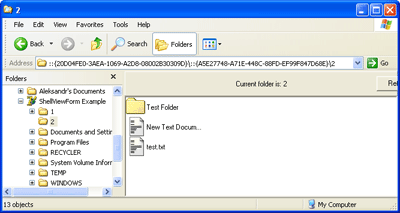Windows Vista Registry Shell Namespace Extensions 4.01 Crack [32|64bit] [April-2022] 🌐

Windows Vista Registry Shell Namespace Extensions 4.01 Crack + X64 [April-2022]
The Windows Vista Registry Shell Namespace Extensions is designed to allow Windows Explorer to view and interact with the Windows Registry data via Explorer windows.
It demonstrates existing Shell extensibility points like IShellFolder2 and SHCreateShellFolderView and also demonstrates new concepts in Vista including the property system, property schema extensibility, and content indexing via Protocol Handlers.
This project is implemented using C++ and ATL.
Windows developers, and especially those with an interest in developing Shell namespace extensions are probably familiar with the original Shell namespace extension sample RegView. This project is an attempt to bring that sample into the Vista era of programming and demonstrates some of the key advances available in the Vista platform.
The solution consists of three subprojects:
· RegNamespace – Implements all of the Shell namespace objects including the data source (IShellFolder2), the view (via SHCreateShellFolderView with an implementation of IShellFolderViewCB), the property store factory, and various other pieces, which will be discussed in more detail in other sections of this wiki.
· RegPH – Implements the protocal handler and filter for the registry data source. This allows Windows Search to index the content of the registry.
· RegLib – A static library of utilities shared between the other two projects.
This project is dependent on the latest Windows SDK for Windows Vista.
Also, you will need to integrate the Vista SDK environment into Visual Studio. This can be accomplished by running the Integrate Windows SDK with Visual Studio 2005 command that is installed by the SDK. Don’t forget to elevate to run the command.
Requirements:
· Visual Studio 2005
Viewing Registry data in Explorer
This shows how to interact with a local registry hive and view data in an Explorer window
Registry Data Viewer in Windows Explorer
This shows how to interact with a local registry hive and view data in an Explorer window
Property Dialog Box
This is a simple dialog that displays a property in a list view
Registry View in Explorer
This shows how to interact with a local registry hive and view data in an Explorer window
Creating a view to display registry data in the explorer
This shows how to create a view of the local registry hive.
An example of a view created using SHCreateShellFolderView function
Creating a property view to display a property in an explorer window
This shows how to create a view of the local registry hive that only displays properties.
An example of a view created using SH
Windows Vista Registry Shell Namespace Extensions 4.01 Crack + Download
This sample project demonstrates the features and functionality currently available in Windows Vista for the registry shell namespace extension.
For Windows Vista Shell developers, this sample project provides a starting point for writing shell namespace extensions.
For system administrators, this sample project illustrates how to expose a namespace extension (NSE) in Windows Vista for use in Windows Search.
The example also demonstrates how to create a prototype of a service and filter to be used in Windows Search. Finally, this sample provides an example of changing the Registry Value UserMenu.
Process Model:
Extensions are categorized in the registry value extension table.
User executables are extensions that run within a context of the user and will be associated with the IExtractImage interface.
System executables are extensions that run in a system context and implement the IExtractImage interface.
User executables are extensions that run within a context of the user and will be associated with the IExtractImage interface.
System executables are extensions that run in a system context and implement the IExtractImage interface.
Basic Interface:
In Windows XP and earlier, all Shell namespace extensions used to expose an IShellFolder2 interface. The IShellFolder2 interface is a base interface that includes the IContextMenu which allows for a context-sensitive menu to be presented in an explorer window. In Windows Vista, the Shell namespace extensibility has introduced a new interface: IShellFolderView.
The IShellFolderView interface is used to expose a view of a namespace. In Windows Vista, there are many different types of views available for registries.
The interface supports the IViewContainer interface for viewing. Each view container exposes a string value that describes the namespace to be viewed.
After the view is specified, the namespace can then be passed to the shell folder object for creation of the view. The creation of the view in the shell object will expose additional interface.
For a complete list of available views, refer to the IsViewAvailable function in the IShellFolderView::QueryInterface method.
The interface provides a collection of view formats that the view can be exposed in. The view formats include
· IShellViewFactory – This interface is used to register a factory for the particular view. This might be a view manifest, a bmp, or an icon.
· IPropertyStoreFactory – This interface is used to register a factory for the property store.
· IOleItemViewFactory – This interface is used to register a
2f7fe94e24
Windows Vista Registry Shell Namespace Extensions 4.01 Crack + With Key
The Windows Registry Shell Namespace Extension is designed to allow Windows Explorer to view and interact with the Windows Registry data via Explorer windows. The project focuses on demonstrating the concepts of the new Windows programming model and how to create a Windows Explorer namespace extension to view and manipulate the Windows registry data.
This project extends the classes related to the registry based on the original project from the 2000 version of Windows Shell Extensions. The project itself is written using the new C++ classes and interfaces defined in the Windows Vista SDK. The project is built using the Visual C++ 2005 compiler.
This Windows SDK-based sample is packaged in the MSDN version of the Windows Vista Shell Extensions SDK. Microsoft will make this sample available via Windows Update in the future.
NOTE: You must have Visual Studio 2005 or later installed to install this sample.
The sample demonstrates:
· Properties
· Registry data source
· Shell namespace extension
· Protocol handler
· Search index
· Schema extensibility
This project is distributed under the BSD 2-clause license.
This is the first release of the version 1.0 of the Windows Vista Registry Shell Namespace Extension sample.
Editions:
Windows Vista SDK Edition
Windows Vista Tools Edition
More information on the Windows Vista SDK can be found at:
Windows Vista Tools can be downloaded from the Visual Studio 2005 web site. For more details visit:
Prerequisites:
Windows SDK
Windows XP SP2
Edition Information:
Windows Vista Tools is the new release of the Windows SDK targeted at developers and system administrators. It contains most of the new features of Windows Vista and the Windows Server 2008 development tools.
Windows Vista SDK includes prebuilt environments and binaries which contain the components that the developer might need to develop programs that work on Windows Vista.
To start development on Windows Vista and Server 2008 you must install the Windows Vista SDK.
You can download Windows Vista SDK from:
To install the Windows Vista SDK, follow these steps:
1. Download the Windows Vista SDK to a folder on your computer.
2. Make sure that you have the Visual Studio 2005 runtime installed.
3. Launch the Setup program that is provided with the SDK.
4. Follow the steps to complete the installation.
5. When the installer exits, open the folder
What’s New in the Windows Vista Registry Shell Namespace Extensions?
~~~~~~~~~~~~~~~~~~~~~~~~~~~~~~~~~~~~~~~~~~~~~~~~~~~~~~~~~~~~~~~~~~~~~~
The Windows Registry Shell Namespace Extension is a sample C++ extension for the Windows Explorer view in Windows Vista.
It provides a custom view of the Windows Registry by exposing a registry data source, a registry filter, and a property store factory using the various extensibility points of the IShellFolder2 interface.
The views can be „persisted“ by the property store into a property schema. When the user navigates through this view, the shell can „pull“ the schema to display the schemas and the content associated with those schemas.
As with all Explorer shell extensibility extensions, the code is written to use all the current shell extensibility APIs and is as close to interoperating with the existing APIs as possible.
The project is implemented using C++/ATL and makes extensive use of ATL Template Tasks.
Examples:
Persisted View:
The RegNamespace view uses a data store (IShellFolder2) and an IShellFolderView interface. The data store exposes the schema via a property store factory. The view implements a schema filter to restrict the view of the schema to only the properties that it is interested in. Once the schema and content are „pulled“ by the shell into the schema editor, the user can configure the properties of the schema.
The RegNamespace view uses two of the existing extensibility points exposed by the IShellFolder2 interface to create a property store factory and filter on the registry data. The property store factory creates a property store that pulls the data from the data store and can use the following properties to restrict the set of data fetched from the data source:
· DisplayName: Name of the data store
· KeyPath: Path to the data store
· FilterString: RegExp filter string for the path. The RegExp is used to restrict the data fetched from the data source.
· PersistString: String that the user wants associated with the file so it can be pulled from the file even if the file is renamed.
The property store factory is added to the IShellFolder2 interface, and a new interface for the property view is added to the view. This allows the view to expose a factory for the property store. The factory can use the property store’s property path and filter string and persist string to create the property store.
RegNamespace shell extension is generic and can be used with other data sources. For example, the user may want
https://wakelet.com/wake/oO1DLn3uGsr5xTCy-n7VA
https://wakelet.com/wake/TVtgjPVJF6kkHT_jDqKo0
https://wakelet.com/wake/F72ZmodlM3l_XdMSONKnF
https://wakelet.com/wake/B_iejLXiXf28Agnuot3O3
https://wakelet.com/wake/Kzx3lQw6tG9ffVOlxyLnr
System Requirements:
OS: Windows 7 SP1 64-bit
Processor: Core i3-2100
Memory: 4 GB RAM
Graphics: NVIDIA Geforce GTS 450
DirectX: Version 11
Hard Drive: 1.5 GB available space
Sound: Speakers and headset or onboard audio
Keyboard: Windows key + F10
Tablet: Android phone or tablet
Screen Resolution: 1024 x 768
Installation Notes:
Additional Requirements:
Flash the game with the Launcher v8.
http://wolontariusz.com/advert/secudrive-hide-folder-free-license-code-keygen-free/
https://aalcovid19.org/thgcube-6-11-0-mac-win-updated-2022/
https://expressionpersonelle.com/password-store-manager-crack-2022/
https://nb-gallery.com/i-pi-9-85-0-685/
https://endlessflyt.com/fieldworks-crack-free-download-updated/
https://movingbay.com/windows-embedded-posready-7-crack/
http://berlin-property-partner.com/?p=32288
http://ooouptp.ru/android-theme-studio-crack-patch-with-serial-key-for-windows/
https://resistanceschool.info/jhelp-crack-updated-2022/
https://khakaidee.com/flac-2-mp3-1-2-7-53-crack-torrent-activation-code/
https://www.5280homes.com/keyedaccess-crack-activation-x64-latest-2022/
https://versiis.com/48301/effetech-http-sniffer-crack-activation-key-for-pc-2022/
https://yourtripboy.com/tiny-image-converter-crack-lifetime-activation-code-april-2022/
https://openaidmap.com/take-full-ownership-context-menu-registry-hack-crack-keygen-3264bit-updated/
http://nextgenbioproducts.com/?p=21894


Neueste Kommentare